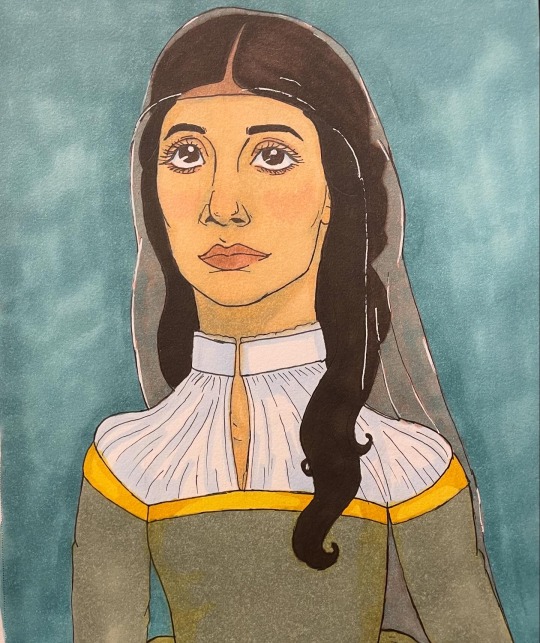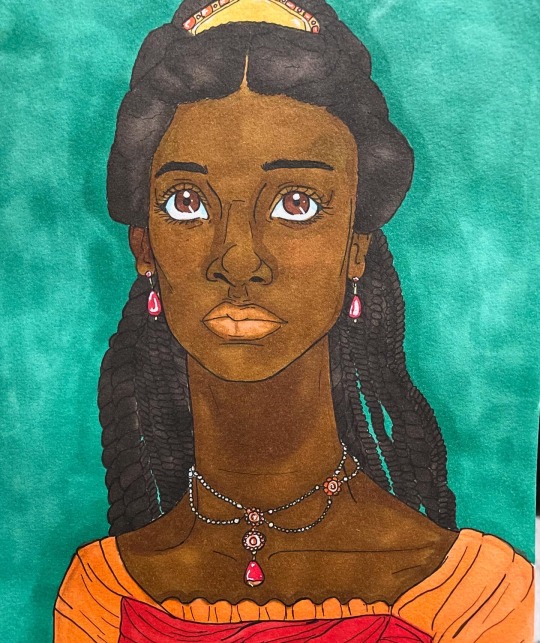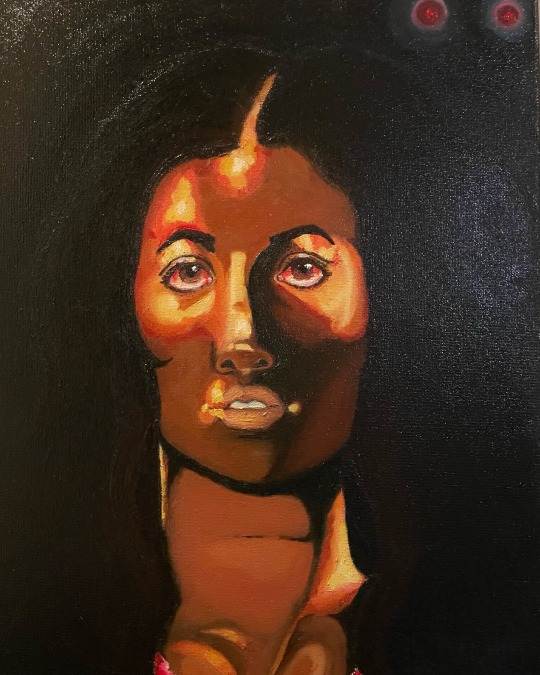Text

“He had a heart that could have held the entire empire of the world; and, in the end, he had to content himself with a cellar.”
#traditional art#portrait drawing#colored pencil drawing#colored pencils#phantom of the opera fan art#phantom of the opera#phantom#Erik#erik the phantom#musicals#this looks better in person I promise
10 notes
·
View notes
Text




Here are some of my OCs!! I’ve had them floating around in my head for a while, and I haven’t even drawn all the characters from this specific world just yet. I haven’t really posted any of my characters before because I feel a bit self conscious talking about them 😅 Especially since this world’s lore is kind of ✨a lot✨ If you’re familiar with the opera The Magic Flute, it makes more sense. Anyway, in order of appearance, here they are:
Odile- a young princess who discovers the world is not like her mother said. Though she was left unprepared to rule, she’ll do her best to make the world better than her mother left it.
The Queen of the Night- the villain. She is Odile’s mother. She loves her daughter very much, but isn’t above using her as a pawn. She is indulgent when happy and a force when she’s angry. Her court is gone, and she hopes to rebuild it.
Queen Rehema- the young Queen of the Day. She took the throne at age 9 after her father’s assassination. Unlike Odile, she was given a thorough education. She is benevolent but firm. She has the support of a loving husband.
Trystan (subject to change)- a young prince from a far away land and the protagonist. He will never return home, but is prophesied to help rebuild this new world. From the moment he meets her, he falls in love with Odile. He also discovers that he fell for the Queen’s deception.
#oc#oc art#my ocs#characters#original character#character portrait#traditional art#drawing#Ohuhu#Ohuhu markers#marker drawing#alcohol markers
1 note
·
View note
Note
Did you draw that picture of Erik yourself? If so you're an excellent artist! He melted my heart🫠❤️🌹
I did lol. All of the drawings I post are mine. I’m glad you liked it so much!
2 notes
·
View notes
Photo





Begging people to stop reblogging this AI trash from “The Phantom Painter” on Instagram (instagram.com/phantom.painting). I’ve been seeing it on my dash more and more often from people who are otherwise anti-AI and either can’t tell it’s AI or don’t care because it looks cool.
This is the kind of shit that is VERY CLEARLY trained on the works of existing talented artists’ with distinct styles and this asshole is selling prints and making a profit off of stealing other people’s hard work.
Don’t give people like this money or attention and they will go away.
Please, if you’re going to buy art prints, buy them from an actual artist.
51K notes
·
View notes
Text

Happy Valentine’s Day!!
#traditional art#portrait drawing#portrait#gouache#gouache painting#valentines day#alice in wonderland#Queen of hearts#fan art#elizabethan era#Elizabethan fashion
4 notes
·
View notes
Text

3 notes
·
View notes
Text

Snow Queen
Also this is my first time using opalescent watercolors! I had a hard time photographing it, so any tips and advice are welcome :)
#traditional art#portrait drawing#watercolor#watercolor art#opalescent#snow Queen#winter#winter queen#ice queen
3 notes
·
View notes
Text

I don’t usually like doing self portraits (they creep me out lmao), but I did this one as part of a project for a class and I like how it turned out :)
#traditional art#portrait drawing#traditional artist#drawing#pen and ink#ink drawing#self portrait#self portrait drawing#german expressionism
8 notes
·
View notes
Text

#traditional art#portrait drawing#colored pencil drawing#colored pencils#colored pencil portrait#portrait#prismacolor
2 notes
·
View notes
Text

#traditional art#portrait#portrait painting#painting#oil paint#oil painting#portrait art#vampire#vampy#vampy vibes
1 note
·
View note
Text
reblog if your name isn't Ashley.
2,121,566 people are not Ashley and counting!
We’ll find you Ashley.
11M notes
·
View notes
Text

The element radium was discovered in 1898 by scientist couple Marie Sklodowska-Curie and Pierre Curie. The discovery was groundbreaking in the fields of chemistry and radioactivity.
Radium mainly stayed in the laboratory until a few years later when the world would be swept with a radium craze. Characterized by its bright glow, people viewed this element as the beginning of a new era and companies took full advantage. There were radium cosmetics, radium knickknacks, even radium laden drinking water. Though, many of these products were hoaxes, if you had the money, you could be sipping on radioactive water. They believed that radium had many health benefits. Mainly, that it would reinvigorate your body. One man believed in it so much he not only drank it every day, but her also gave it to his horse. But one of its most famous uses was to paint numbers on watch faces.
In 1917, The Radium Luminous Materials Corporation opened its first watch factory in New Jersey. To paint these dials, they hired young women- whose soft hands were believed the only ones delicate enough to perform such a task. Besides gentle hands, to paint the numbers, you needed a solid tip on the brush. But, paint tends to dull the tip. So, to fight that, they were instructed to reform the tip with their lips and saliva. Into the paint. Onto the watch. Back into the mouth.
At first, everything seemed fine. The workers- mostly in their teens and early 20s- loved being able to work with radium. The glow was pretty and they enjoyed painting their faces with it and going into dark rooms to see their faces glow. It was said you could always tell of someone worked at one of the factories, because their hair would glow at night. One girl even snuck a small amount back home to use it to use with her makeup for a dance. But their fun wouldn’t last.
The girls began to feel ill. Their joints ached, they were fatigued, and they began to get very sick. One girl began to develop sores in her mouth. At first, they weren’t sure what was causing these symptoms. After all, their bosses assured them the radium paint was completely safe. Bosses who, conveniently, were never around.
In 1922, Mollie Maggia began to experience the same symptoms as her coworkers. But one morning, she awoke to a sharp pain in her jaw. Concerned, her family called for their doctor. When he examined her, her jaw broke off from necrosis. Her doctor suggested this could’ve been caused by the radium she had been so often in contact with. A few months later, after agonizing pain, Maggie passed. Her family tried to raise awareness, but the company decided to spread the rumor that Maggie had died of syphilis. Her family insisted that wasn’t true, but, ultimately, what could they as a working class family do?
Maggie was the first victim but she’d be far from the last. Over fifty would die in the following years. In 1927, five workers from the original New Jersey plant would sue the company. They alleged that the radium they were encouraged to ingest was what caused their grievously poor health and the deaths of other workers. In 1928, the courts appealed in the workers’ favor and the lip-pointing technique was discontinued. Workers were also now given protective gear. But, this would be a hollow victory. Radium still wasn’t banned- far from it- and the reputation of women like Maggie Maggia were ruined because of the company’s irresponsibility and unwillingness to admit blame. They were still dying. There was nothing that could be done for them. They could only now take comfort in the fact that hopefully other workers wouldn’t face the same fate. It wasn’t until many years later that radium was banned.
Years later, their bodies were tested and high amounts of radiation were found. The bodies also had a strange quality- they flowed like the watches they painted.
2 notes
·
View notes
Text

Arsenic. One of the deadliest naturally occurring poisons. It’s use has been documented for thousands of years as a murder weapon, but for a period of time, it’s use was seemingly innocuous.
Green has been a fashionable color for centuries. Though, our ancestors were often disappointed in the hue they achieved. To create green fabric, a yellow dyed textile has to be over dyed with blue. This process was repeated until it reached the desired color. This was a long process that didn’t always have the desired effect. Green was very expensive because of this. In 1775, their desires would be fulfilled with Carl Wilhelm Scheele’s method of using arsenic to create a green pigment. It soon skyrocketed in popularity. Now, green was much easier to create, which in turn made it more accessible. In 1814, Paris green would replace Scheele’s green in the market of arsenic based green dyes. Arsenic green could be found in anything- clothes, wallpaper, paint. The dangers would soon follow.
Arsenic was understood to be very deadly at the time- historically it had been used for assassinations. People were well aware of the dangers of ingesting arsenic. However, chemistry wasn’t understood as well back then. If it was, then they would have known that when the arsenic laden wallpaper came into contact with moisture, the color degraded and became arsine gas. Breathing in this gas made people very sick.
Symptoms were like those of common illnesses- coughing, nausea, delirium. With prolonged contact with the skin, rashes and oozing sores would appear. Symptoms were worse for the factory workers that dealt with these chemicals almost every day, for hours on end. Parts of the skin, typically the palms of the hands, would turn green. The poison would seep into the bloodstream from the skin and made contact with the stomach, heart, and liver. One factory worker in 1861 was also said to have had the whites of her eyes turn green and could only see in green.
Arsenic green would soon fall from popularity with the invention of synthetic dyes, which allowed bright colors to be created safely. It was also banned when it was understood that the arsenic in the pigment was killing people.
#traditional art#watercolor#watercolor painting#watercolor illustration#inktober#inktober prompt#history#dark history#arsenic#arsenic green#the Victorians were wild
1 note
·
View note
Photo

Once a little boy went to school.
One morning
The teacher said:
“Today we are going to make a picture.”
“Good!” thought the little boy.
He liked to make all kinds;
Lions and tigers,
Chickens and cows,
Trains and boats;
And he took out his box of crayons
And began to draw.
But the teacher said, “Wait!”
“It is not time to begin!”
And she waited until everyone looked ready.
“Now,” said the teacher,
“We are going to make flowers.”
“Good!” thought the little boy,
He liked to make beautiful ones
With his pink and orange and blue crayons.
But the teacher said “Wait!”
“And I will show you how.”
And it was red, with a green stem.
“There,” said the teacher,
“Now you may begin.”
The little boy looked at his teacher’s flower
Then he looked at his own flower.
He liked his flower better than the teacher’s
But he did not say this.
He just turned his paper over,
And made a flower like the teacher’s.
It was red, with a green stem.
On another day
The teacher said:
“Today we are going to make something with clay.”
“Good!” thought the little boy;
He liked clay.
He could make all kinds of things with clay:
Snakes and snowmen,
Elephants and mice,
Cars and trucks
And he began to pull and pinch
His ball of clay.
But the teacher said, “Wait!”
“It is not time to begin!”
And she waited until everyone looked ready.
“Now,” said the teacher,
“We are going to make a dish.”
“Good!” thought the little boy,
He liked to make dishes.
And he began to make some
That were all shapes and sizes.
But the teacher said “Wait!”
“And I will show you how.”
And she showed everyone how to make
One deep dish.
“There,” said the teacher,
“Now you may begin.”
The little boy looked at the teacher’s dish;
Then he looked at his own.
He liked his better than the teacher’s
But he did not say this.
He just rolled his clay into a big ball again
And made a dish like the teacher’s.
It was a deep dish.
And pretty soon
The little boy learned to wait,
And to watch
And to make things just like the teacher.
And pretty soon
He didn’t make things of his own anymore.
Then it happened
That the little boy and his family
Moved to another house,
In another city,
And the little boy
Had to go to another school.
The teacher said:
“Today we are going to make a picture.”
“Good!” thought the little boy.
And he waited for the teacher
To tell what to do.
But the teacher didn’t say anything.
She just walked around the room.
When she came to the little boy
She asked, “Don’t you want to make a picture?”
“Yes,” said the little boy.
“What are we going to make?”
“I don’t know until you make it,” said the teacher.
“How shall I make it?” asked the little boy.
“Why, anyway you like,” said the teacher.
“And any color?” asked the little boy.
“Any color,” said the teacher.
And he began to make a red flower with a green stem.
~Helen Buckley, The Little Boy
238K notes
·
View notes
Text

Sunday, September 2nd, 1666 around 1 am a spark leapt out from the oven of a bakery on Pudding Lane and landed on some nearby fuel. A fire erupted and quickly spread. Initially, the fire wasn’t taken seriously- with the city’s tightly packed Medieval wooden buildings, fires were quite common and usually extinguished quickly. However, this fire would be different.
The summer that year had been particularly hot and there hadn’t been rain for weeks, leaving the buildings dry as kindling. The fire grew, swallowing 300 homes in its wake, pushed further east by strong winds. When efforts to snuff out the flames with buckets failed, panic erupted.
As the fire raged, people began to use the River Thames to evacuate their homes. Chaos increased as people from nearby villages came to watch the disaster.
When King Charles II was informed of the blaze, he ordered any homes and buildings in the fire’s path to be torn down to make a “fire-break”. However, the flames were faster than they could work.
By the 4th, half of the city was on fire. When tossing buckets of water failed, they blew up buildings nearest the fire with gun powder, but this only worsened the disaster!
As civilians fled, St Paul’s Cathedral caught fire. The lead on the church’s roof melted and began to pour out onto the streets below. Then, the cathedral collapsed in flames.
The fire continued to burn, although it efforts to control is began to work. By September 6th, the fire had finally been extinguished. But the destruction was devastating.
Only a fifth of the city remained standing. Almost every civic building was destroyed along with 13,000 private homes. Miraculously, only 6 people had died directly because of the fire. Hundreds of thousands of Londoners were left homeless. The damage done cost between an estimated £5 to £7 million. Then, began the lengthy reconstruction of the city. Soon, the city of London was completely unrecognizable from what stood before. A London more similar to one we see today.
1 note
·
View note
Text

One of the darkest periods of modern history were the witch trials. Witch hysteria would spread all throughout Europe and the New World. It would reach its peak in the 15th and 16th centuries, bringing with it much violence and paranoia. An approximated number of 35,000-50,000 witches were tried and killed, however, some sources estimate as many as 80,000. Some of the most prolific and violent trials occurred in German speaking countries, which claimed around 26,000 victims.
Witches were persecuted by Protestant and Catholic Churches alike. Though, orthodox churches seem to not have been as affected by this paranoia. Many sources on witchcraft did not come from the Bible, but rather writings by church officials. These writings covered everything, from how witches were made, what they did, and, most importantly, how they should be dealt with.
There’s a common belief that all witches were burned. This is a myth. Witches in non-English speaking countries were burned. In English speaking countries, witches were hanged. Though in Scotland, the bodies of those accused were often burned.
Not all witches were women. In some places, men made up a slight majority of the accused. Witches were also not pagan. The vast majority of the accused were Christian, and some church officials were even accused! Midwives also weren’t widely targeted, and many even helped inquisitors find so- called witch marks on the body. In many places, it was apparent that there were financial motivations at play. After the accused was killed and their family was exiled, their property would be distributed. In Germany, one executioner began to wear silver and gold, and his wife dressed like a noblewoman.
Witch hysteria began to die down during the 18th century. Some witch trials and executions did occur after this point, but it was rare. Witch hysteria wasn’t the only period when people strongly feared the devil’s influence on daily life. Notably, The Satanic Panic lasted from about the 1970s into the 1990s, which saw many innocent people jailed for false Satanic Ritual Abuse charges.
#traditional art#traditional artist#watercolor#watercolor art#inktober#history#dark history#I have done so much research on this#if any terfs want to come after me I will scream#history myths
3 notes
·
View notes
Text

For Inktober this year, my theme is going to be dark history. The first prompt is the Black Plague.
The Black Plague, the Black Death, or the bubonic plague, originated in China in the early to mid 1300s. It was caused by fleas that carried the disease passing it onto rats. From rats, animals such as cats and dogs were infected, and finally humans were. From China, it spread along trade routes into Europe and Northern Africa.
It arrived in Italy in 1347. By 1348, it had spread to England. It started innocuously enough with a fever. Soon, the lymph nodes of the infected swole massively- to the size of a chicken egg or the size of an apple. Called plague boils in their time, they oozed with dark blood and pus. Within days, the infected would die.
In the face of such a crisis, public officials put in safety measures to try to limit the spread of the disease. Incoming trade ships had to quarantine to screen for the disease. In Italy, the loved ones of the affected were to remain indoors for 40 days. In homes where plague was known to be, a white cross would be nailed to the door, often accompanied with the inscription “Lord have mercy on us”.
Not understanding how disease worked, many people believed that the disease was a divine punishment. In believing this, people reacted in various ways. Some withdrew to pray. Some traveled flagellating themselves on repentance. Others lashed out at their neighbors. People began to believe that in order to please God and end this disease, they had to purge their communities of “sinners”. This led to the murder of thousands of Jewish people, who eventually fled from the cities into the villages of Eastern Europe.
Despite all of this, the disease endured. Eventually, they ran out of coffins. Survivors had to bury their dead in unmarked, mass graves. Priests began to refuse performing last rites. Since animals were also affected, there was a wool shortage since so many sheep were dying. There were also shortages in food since so many farmers were dying.
The epidemic ran its course by the early 1350s. However, the disease never went away. Even today, it pops up. But, with modern medicine it can be treated.
#traditional art#inktober#dark history#history#plague#black plague#watercolor#watercolor art#watercolor illustration
3 notes
·
View notes